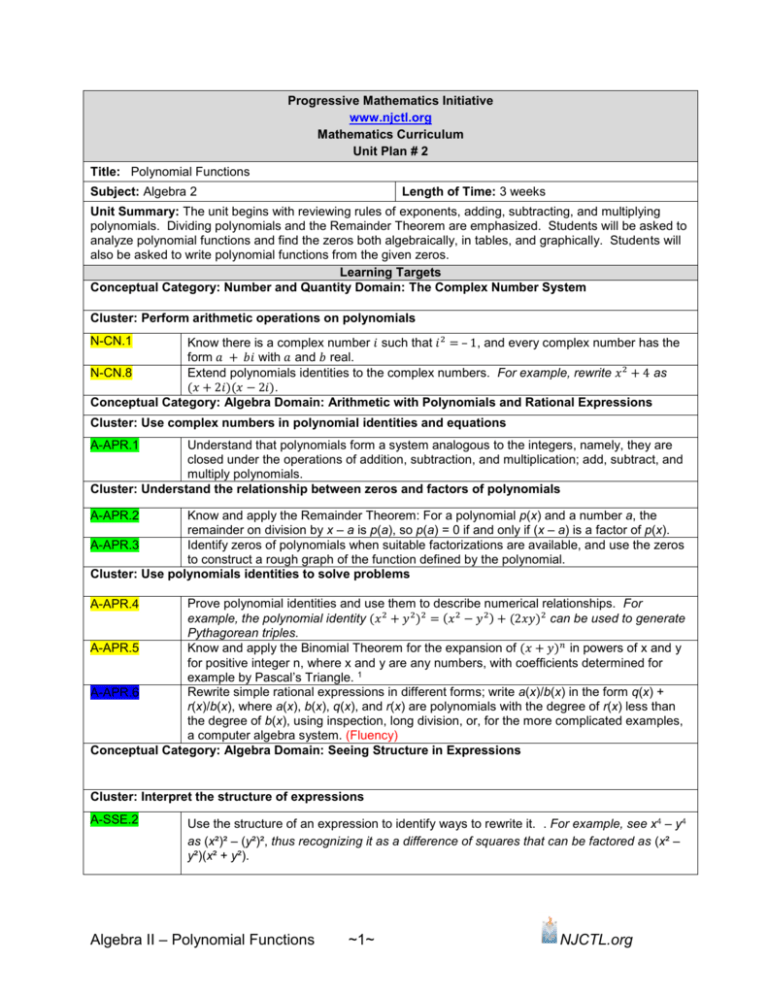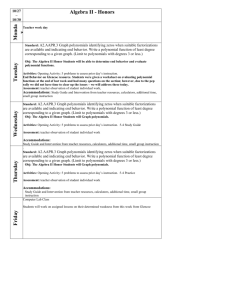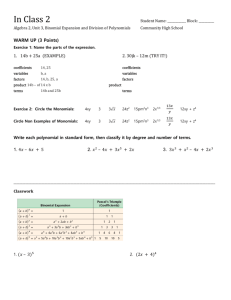Progressive Mathematics Initiative www.njctl.org Mathematics
advertisement

Progressive Mathematics Initiative www.njctl.org Mathematics Curriculum Unit Plan # 2 Title: Polynomial Functions Subject: Algebra 2 Length of Time: 3 weeks Unit Summary: The unit begins with reviewing rules of exponents, adding, subtracting, and multiplying polynomials. Dividing polynomials and the Remainder Theorem are emphasized. Students will be asked to analyze polynomial functions and find the zeros both algebraically, in tables, and graphically. Students will also be asked to write polynomial functions from the given zeros. Learning Targets Conceptual Category: Number and Quantity Domain: The Complex Number System Cluster: Perform arithmetic operations on polynomials Know there is a complex number 𝑖 such that 𝑖 2 = – 1, and every complex number has the form 𝑎 + 𝑏𝑖 with 𝑎 and 𝑏 real. N-CN.8 Extend polynomials identities to the complex numbers. For example, rewrite 𝑥 2 + 4 as (𝑥 + 2𝑖)(𝑥 − 2𝑖). Conceptual Category: Algebra Domain: Arithmetic with Polynomials and Rational Expressions N-CN.1 Cluster: Use complex numbers in polynomial identities and equations A-APR.1 Understand that polynomials form a system analogous to the integers, namely, they are closed under the operations of addition, subtraction, and multiplication; add, subtract, and multiply polynomials. Cluster: Understand the relationship between zeros and factors of polynomials Know and apply the Remainder Theorem: For a polynomial p(x) and a number a, the remainder on division by x – a is p(a), so p(a) = 0 if and only if (x – a) is a factor of p(x). A-APR.3 Identify zeros of polynomials when suitable factorizations are available, and use the zeros to construct a rough graph of the function defined by the polynomial. Cluster: Use polynomials identities to solve problems A-APR.2 Prove polynomial identities and use them to describe numerical relationships. For example, the polynomial identity (𝑥 2 + 𝑦 2 )2 = (𝑥 2 − 𝑦 2 ) + (2𝑥𝑦)2 can be used to generate Pythagorean triples. A-APR.5 Know and apply the Binomial Theorem for the expansion of (𝑥 + 𝑦)𝑛 in powers of x and y for positive integer n, where x and y are any numbers, with coefficients determined for example by Pascal’s Triangle. 1 Rewrite simple rational expressions in different forms; write a(x)/b(x) in the form q(x) + A-APR.6 r(x)/b(x), where a(x), b(x), q(x), and r(x) are polynomials with the degree of r(x) less than the degree of b(x), using inspection, long division, or, for the more complicated examples, a computer algebra system. (Fluency) Conceptual Category: Algebra Domain: Seeing Structure in Expressions A-APR.4 Cluster: Interpret the structure of expressions A-SSE.2 Use the structure of an expression to identify ways to rewrite it. . For example, see x⁴ – y⁴ as (x²)² – (y²)², thus recognizing it as a difference of squares that can be factored as (x² – y²)(x² + y²). Algebra II – Polynomial Functions ~1~ NJCTL.org A-SSE.3 Choose and produce an equivalent form of an expression to reveal and explain properties of the quantity represented by the expression.★ Cluster: Reasoning with Equations and Inequalities A-REI.11 Explain why the x-coordinates of the points where the graphs of the equations y = f(x) and y = g(x) intersect are the solutions of the equation f(x) = g(x); find the solutions approximately, e.g., using technology to graph the functions, make tables of values, or find successive approximations. Include cases where f(x) and/or g(x) are linear, polynomial, rational, absolute value, exponential, and logarithmic functions.★ (For this unit, linear, polynomial and absolute value only.) Conceptual Category: Functions Domain: Interpreting Functions Cluster: Analyze functions using different representations F-IF.4 For a function that models a relationship between two quantities, interpret key features of graphs and tables in terms of the quantities, and sketch graphs showing key features given a verbal description of the relationship. Key features include: intercepts; intervals where the function is increasing, decreasing, positive, or negative; relative maximums and minimums; symmetries; end behavior; and periodicity.★ Graph functions expressed symbolically and show key features of the graph, by hand in simple cases and using technology for more complicated cases Unit Essential Question: Unit Enduring Understandings: How are factors, zeros and x-intercepts related for Like terms have the same bases with the a polynomial function? same degrees. Graphs of polynomials have end behaviors Does knowing the zeros of a function give you dependent on the degree and leading enough information to sketch it? coefficient of the polynomial Division of Polynomials follow the rules of long division The total number of zeros (real and imaginary) is equal to the degree of the polynomial. Unit Objectives: Students will be able to combine polynomial functions using operations of addition, subtraction, multiplication, and division and will be fluent in factoring all types of polynomials. Students will know and be able to apply the Remainder Theorem. Students will be to describe characteristics of polynomials given equations, tables, and graphs. Students will be able to find the zeros of a polynomial, both real and imaginary. Students will be able to write polynomials from its given zeros. Evidence of Learning Formative Assessments: SMART Response questions used throughout the unit. 4 Quizzes Summative Assessment: Unit Test Lesson Plan Topics Timeframe F-IF.7 Topic #1: Properties of Exponents Review Topic #2: Operations with Polynomials Review Quiz 1 Exponents, Addition, Subtraction and Multiplication of Polynomials Topic #3: Special Binomial Products Topic #4: Binomial Theorem Algebra II – Polynomial Functions ~2~ .5 1.5 .5 1 NJCTL.org Topic #5: Factoring Polynomials Review Quiz 2 Special Binomial Products, Binomial Theorem, Factoring Topic #6: Dividing Polynomials Quiz 2 Dividing Polynomials and the Remainder Theorem Topic #7: Polynomial Functions Lab: Exploration of the Values of Terms in a Polynomial Lab: Polynomials Discovery Topic #8: Analyzing Graphs and Tables of Polynomials Quiz 3 Characteristics of Polynomials Topic #9: Zeros and Roots of Polynomial Functions Topic #10: Writing Polynomials from its Zeros Quiz 4 Analyzing Graphs and Tables of Polynomials and Roots of Polynomial Functions Topic #11: Review and Unit Test Curriculum Resources: www.njctl.org/courses/math/algebra2/ www.geogebra.org 2 2 2 1 2 .5 2 ★Modeling Major Supporting Additional Algebra II – Polynomial Functions ~3~ NJCTL.org








